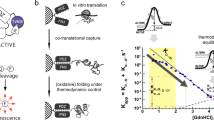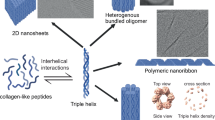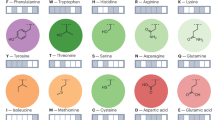Abstract
Designer peptides have recently been developed as building blocks for novel self-assembled materials with stimuli-responsive properties. To date, such materials have been based on self-assembly in bulk aqueous solution or at solid–fluid interfaces. We have designed a 21-residue peptide, AM1, as a stimuli-responsive surfactant that switches molecular architectures at a fluid–fluid interface in response to changes in bulk aqueous solution composition. In the presence of divalent zinc at neutral pH, the peptide forms a mechanically strong ‘film state’. In the absence of metal ions or at acid pH, the peptide adsorbs to form a mobile ‘detergent state’. The two interfacial states can be actively and reversibly switched. Switching between the two states by a change in pH or the addition of a chelating agent leads to rapid emulsion coalescence or foam collapse. This work introduces a new class of surfactants that offer an environmentally friendly approach to control the stability of interfaces in foams, emulsions and fluid–fluid interfaces more generally.
This is a preview of subscription content, access via your institution
Access options
Subscribe to this journal
Receive 12 print issues and online access
$259.00 per year
only $21.58 per issue
Buy this article
- Purchase on SpringerLink
- Instant access to full article PDF
Prices may be subject to local taxes which are calculated during checkout




Similar content being viewed by others
References
He, L. Z., Dexter, A. F. & Middelberg, A. P. J. Biomolecular engineering at interfaces. Chem. Eng. Sci. 61, 989–1003 (2006).
Fairman, R. & Akerfeldt, K. S. Peptides as novel smart materials. Curr. Opin. Struct. Biol. 15, 453–463 (2005).
Morreale, G., Lee, E. G., Jones, D. B. & Middelberg, A. P. J. Bioprocess-centered molecular design (BMD) for the efficient production of an interfacially active peptide. Biotechnol. Bioeng. 87, 912–923 (2004).
Zhang, S. & Zhao, X. Design of molecular biological materials using peptide motifs. J. Mater. Chem. 14, 2082–2086 (2004).
Rajagopal, K. & Schneider, J. P. Self-assembling peptides and proteins for nanotechnological applications. Curr. Opin. Struct. Biol. 14, 480–486 (2004).
Kohn, W. D. & Hodges, R. S. De novo design of α-helical coiled coils and bundles: models for the development of protein-design principles. Trends Biotechnol. 16, 379–389 (1998).
Cohen, C. & Parry, D. A. D. α-Helical coiled coils and bundles: how to design an α-helical protein. Proteins Struct. Funct. Genet. 7, 1–15 (1990).
Zhang, S. G. & Altman, M. Peptide self-assembly in functional polymer science and engineering. React. Funct. Polym. 41, 91–102 (1999).
Petka, W. A., Harden, J. L., McGrath, K. P., Wirtz, D. & Tirrell, D. A. Reversible hydrogels from self-assembling artificial proteins. Science 281, 389–392 (1998).
Schneider, J. P. et al. Responsive hydrogels from the intramolecular folding and self-assembly of a designed peptide. J. Am. Chem. Soc. 124, 15030–15037 (2002).
Hartgerink, J. D., Beniash, E. & Stupp, S. I. Self-assembly and mineralization of peptide-amphiphile nanofibers. Science 294, 1684–1688 (2001).
Vauthey, S., Santoso, S., Gong, H. Y., Watson, N. & Zhang, S. G. Molecular self-assembly of surfactant-like peptides to form nanotubes and nanovesicles. Proc. Natl Acad. Sci. USA 99, 5355–5360 (2002).
Lu, J. R. et al. Interfacial nano-structuring of designed peptides regulated by solution pH. J. Am. Chem. Soc. 126, 8940–8947 (2004).
Stevens, M. M. et al. pH-Dependent behavior of surface-immobilized artificial leucine zipper proteins. Langmuir 20, 7747–7752 (2004).
Hong, Y. S., Lau, L. S., Legge, R. L. & Chen, P. Critical self-assembly concentration of an ionic-complementary peptide EAK16-I. J. Adhes. 80, 913–931 (2004).
Middelberg, A. P. J., Radke, C. J. & Blanch, H. W. Peptide interfacial adsorption is kinetically limited by the thermodynamic stability of self association. Proc. Natl Acad. Sci. USA 97, 5054–5059 (2000).
Degrado, W. F. & Lear, J. D. Induction of peptide conformation at apolar/water interfaces. 1. A study with model peptides of defined hydrophobic periodicity. J. Am. Chem. Soc. 107, 7684–7689 (1985).
Bos, M. A. & van Vliet, T. Interfacial rheological properties of adsorbed protein layers and surfactants: a review. Adv. Colloid Interface Sci. 91, 437–471 (2001).
Wilde, P. J. Interfaces: their role in foam and emulsion behaviour. Curr. Opin. Colloid Interface Sci. 5, 176–181 (2000).
Jones, D. B. & Middelberg, A. P. J. Micromechanical testing of interfacial protein networks demonstrates ensemble behaviour characteristic of a nanostructured biomaterial. Langmuir 18, 5585–5591 (2002).
McClements, D. J. Protein-stabilized emulsions. Curr. Opin. Colloid Interface Sci. 9, 305–313 (2004).
Tcholakova, S., Denkov, N. D., Sidzhakova, D., Ivanov, I. B. & Campbell, B. Effects of electrolyte concentration and pH on the coalescence stability of β-lactoglobulin emulsions: experiment and interpretation. Langmuir 21, 4842–4855 (2005).
Das, K. P. & Kinsella, J. E. Effect of heat denaturation on the adsorption of beta-lactoglobulin at the oil-water interface and on coalescence stability of emulsions. J. Colloid Interface Sci. 139, 551–560 (1990).
Dickinson, E., Murray, B. S. & Stainsby, G. Coalescence stability of emulsion-sized droplets at a planar oil-water interface and the relationship to protein film surface rheology. J. Chem. Soc. Faraday Trans. I 84, 871–883 (1988).
Aveyard, R. & Clint, J. H. Foam and thin film breakdown processes. Curr. Opin. Colloid Interface Sci. 1, 764–770 (1996).
van Aken, G. A. in Food Emulsions (eds Friberg, S. E., Larsson, K. & Sjoblom, J.) 299–325 (Marcel Dekker, New York, 2004).
Fairman, R. et al. Characterization of a new four-chain coiled-coil: influence of chain length on stability. Protein Sci. 4, 1457–1469 (1995).
Jones, D. B. & Middelberg, A. P. J. Mechanical properties of interfacially adsorbed peptide networks. Langmuir 18, 10357–10362 (2002).
Jones, D. B. & Middelberg, A. P. J. Direct determination of the mechanical properties of an interfacially adsorbed protein film. Chem. Eng. Sci. 57, 1711–1722 (2002).
Cameron, D. R., Weber, M. E., Idziak, E. S., Neufeld, R. J. & Cooper, D. G. Determination of interfacial areas in emulsions using turbidimetric and droplet size data: correction of the formula for emulsifying activity index. J. Agric. Food Chem. 39, 655–659 (1991).
Adam, N. K. & Miller, J. G. F. The structure of surface films Part XIX—The effect of alkaline solutions on films with various end groups. Proc. R. Soc. Lond. A 142, 416–422 (1933).
Schulman, J. H. & Hughes, A. H. On the surface of unimolecular films-Part IV—The effect of the underlying solution and transition phenomena in the film. Proc. R. Soc. Lond. A 138, 430–450 (1932).
Adam, N. K. & Miller, J. G. F. The structure of surface films Part XVIII—The effect of alkalinity in the underlying solution on films of fatty acids. Proc. R. Soc. Lond. A 142, 401–415 (1933).
Rosano, H. L., Christodoulou, A. P. & Feinstein, M. E. Competition of cations at charged micelle and monolayer interfaces. J. Colloid Interface Sci. 29, 335–344 (1969).
Goddard, E. D. & Ackilli, J. A. Monolayer properties of fatty acids. J. Colloid Sci. 18, 585–595 (1963).
Sengupta, T. & Papadopoulos, K. D. Kemps triacid at oil-water interfaces. J. Colloid Interface Sci. 163, 234–244 (1994).
Kanicky, J. R., Poniatowski, A. F., Mehta, N. R. & Shah, D. O. Cooperativity among molecules at interfaces in relation to various technological processes: Effect of chain length on the pK(a) of fatty acid salt solutions. Langmuir 16, 172–177 (2000).
Sengupta, T., Yates, M. & Papadopoulos, K. D. Metal complexation with surface-active Kemp’s triacid. Colloids Surf. A 148, 259–270 (1999).
Jong, L. I. & Abbott, N. L. A chemodegradable surfactant system based on oxidation of disulfide bonds using hypochlorite. Langmuir 16, 5553–5561 (2000).
Chen, C. M., Lu, C. H., Chang, C. H., Yang, Y. M. & Maa, J. R. Influence of pH on the stability of oil-in-water emulsions stabilized by a splittable surfactant. Colloids Surf. A 170, 173–179 (2000).
Gallardo, B. S. & Abbott, N. L. Active control of interfacial properties: a comparison of dimeric and monomeric ferrocenyl surfactants at the surface of aqueous solutions. Langmuir 13, 203–208 (1997).
Shin, J. Y. & Abbott, N. L. Using light to control dynamic surface tensions of aqueous solutions of water soluble surfactants. Langmuir 15, 4404–4410 (1999).
Burgess, D. J. & Sahin, N. O. Interfacial rheological and tension properties of protein films. J. Colloid Interface Sci. 189, 74–82 (1997).
Martin, A. H., Grolle, K., Bos, M. A., Stuart, M. A. & van Vliet, T. Network forming properties of various proteins adsorbed at the air/water interface in relation to foam stability. J. Colloid Interface Sci. 254, 175–183 (2002).
Abbott, N. L. New horizons for surfactant science in chemical engineering. AIChE J. 47, 2634–2639 (2001).
Windhab, E., Dressler, M., Feigl, K., Fischer, P. & Megias-Alguacil, D. Emulsion processing—from single-drop deformation to design of complex processes and products. Chem. Eng. Sci. 60, 2101–2113 (2005).
Jones, D. B. & Middelberg, A. P. J. Interfacial protein networks and their impact on droplet breakup. AIChE J. 49, 1533–1541 (2003).
Acknowledgements
The authors acknowledge financial support from the Australian Research Council (Grant FF0348465). A.F.D. acknowedges a University of Queensland Postdoctoral Research Fellowship. A.S.M. acknowledges an Australian Postgraduate Award and a University of Queensland School of Engineering Super Scholarship. A.P.J.M. acknowledges an Australian Research Council Federation Fellowship. This research was facilitated by access to the Australian Proteome Analysis Facility established under the Australian Government’s Major National Research Facilities program. Patent applied for.
Author information
Authors and Affiliations
Corresponding author
Ethics declarations
Competing interests
International patent application PCT/AU2006/00236, Peptide Networks, relates to this work.
Rights and permissions
About this article
Cite this article
Dexter, A., Malcolm, A. & Middelberg, A. Reversible active switching of the mechanical properties of a peptide film at a fluid–fluid interface. Nature Mater 5, 502–506 (2006). https://doi.org/10.1038/nmat1653
Received:
Accepted:
Published:
Issue date:
DOI: https://doi.org/10.1038/nmat1653
This article is cited by
-
Non-linear dilational rheology of liquid-liquid interfaces stabilized by dipeptide hydrogels
Rheologica Acta (2023)
-
A minimal length rigid helical peptide motif allows rational design of modular surfactants
Nature Communications (2017)
-
Tyrosine-mediated two-dimensional peptide assembly and its role as a bio-inspired catalytic scaffold
Nature Communications (2014)
-
CO2/N2 Triggered Switchable Surfactants with Imidazole Group
Journal of Surfactants and Detergents (2014)
-
Molecular dynamics approach to investigate the coupling of the hydrophilic–lipophilic balance with the configuration distribution function in biosurfactant-based emulsions
Journal of Molecular Modeling (2013)



